![]()
![]()
![]()
Use LEFT and RIGHT arrow keys to navigate between flashcards;
Use UP and DOWN arrow keys to flip the card;
H to show hint;
A reads text to speech;
20 Cards in this Set
- Front
- Back
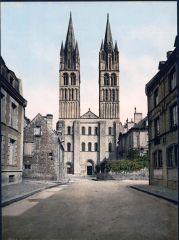
|
St. Étienne, Caen, France, begun 1067 ROMANESQUE PERIOD
• Capital city of William the Conqueror • Dedicated to St. Stephen (Stefanos in Greek is “crown”) who becomes a patron saint to those royal o Dedicated to “the crown” by William • Thick walls on the west end which indicates that on that end will large towers be built; to support the weight • #3 patterns everywhere: in the windows, arches, etc which are symbolic of the trinity o the elevation of the stories also complements this • Harmonic façade because of the relations • Inside o Transverse arches o In the cross-vaulting (which reaches every-other pier) o Sexpartite rib vault which will become standard in early gothic architecture • William was almost buried here but only a leg bone remains because the stench of the body was so foul, someone threw it into the river |
|

|
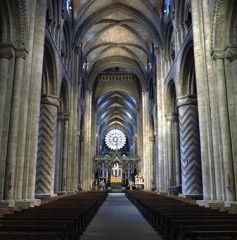
Cathedral, Durham, England, begun c. 1093 ROMANESQUE PERIOD
• The two towers in the front are not the dominant figures but is the tower that crosses the nave • The east end with the spires was rebuilt • “Screen façade”; the west end makes the building look wider than it really is • Early example of English “flying buttress” which supports the weight of the vaulting to “flying over” gallery to the exterior wall o First time we see this in architecture instead of creating incredibly large walls=>create much smaller piers on the inside • Inside o Larger and smaller columns alternate • Compound piers are the larger piers but they look like a bundle of smaller piers • Two cross vaulting (Heptpartide-7) per square layout between piers/bays • Two transverse arches with a couple that are slightly pointed, one that is round |
|

|
Facade Sculpture, Cathedral, Modena, Italy, c. 1110, Artist: Wiligelmus ROMANESQUE PERIOD
• In terms of the proportions, it is very reminiscent of art on sarcophogis o Rectangular shape with art detailed onto the façade o Characters are identified; first panel is of the creation • No definition of muscles, somewhat natural proportions • Some architectural framework by means of the use of vaulted arches and the columns are used to divide the scenes • Sculpture in the round returns |
|
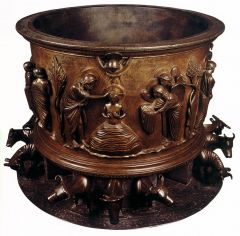
|
Baptismal Font, 1107-1118 Artist: Reiner of Huy ROMANESQUE PERIOD
• Artist is obviously inspired by Roman Classical style of proportions and naturalistic physiological features • 12 oxen represent the twelve Tribes; obvious that the artist was looking back at early Christian art o Christ has no beard o Intense drapery and there is a visual of the underlying figure; the dove of the holy spirit is above Christ’s head o The small arc represents heaven and the father is seen peaking out of heaven with only the top of his head seen |
|
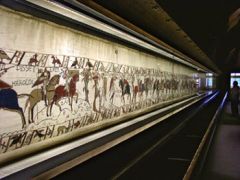
|
Bayeux Tapestry, 1070-80, embroidery ROMANESQUE PERIOD
• Depicts the story of the Norman conquest of England • Read like a book • Begins with the death of King Edward being taken to Westminster Abby o Dispute breaks out as to who should be King of England o Battle of Hastings is fought o Inspiration was probably the column of Trajan which is narrating a victory o Certainly something that would’ve been done by women artists based on the nature of its creation |
|
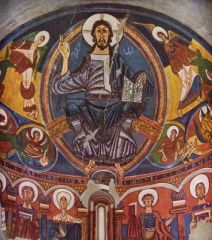
|
Christ in Majesty, San Clemente, Taull, Spain, 1123 ROMANESQUE PERIOD
• Not traditional for the period to decorate apses with mosaics • Sitting on a rainbow which means that he is ruling from the arc of heaven o Making the gesture of blessing with his right hand • Alpha and the Omega on his shoulders • Styles purely Romanesque o Bright coloring o Limited modeling o Flat and two dimensional-looking figure that may look cartoonish o Drapery folds that are horizontal across the chest instead of vertical o Dark heavy outlines • Figures below have halos with dark outlines |
|

|
Vision of St. Hildegard of Bingen, Liber Scivias, c. 1165 ROMANESQUE PERIOD
• Collection of St. Hildegard • One of the first holy-woman and very visionary/spiritual • Having a hard time understanding the book of Isaiah; spirit descended upon her and she was then able to understand; priest/confessor saw the spirit descend upon her in flames • Not illusionistic; church is shown symbolically cause you can see the roof tiles and the outside of the building; understand that she is on the inside • Limited modeling and realistic shading, lighting, and outlining |
|
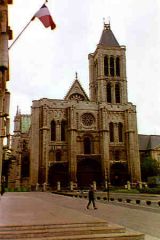
|
Abbey Church of St. Denis, near Paris, France, 1140-44, - Abbot Suger, pseudo- Dionysius the Areopagite GOTHIC PERIOD
• French version of Dionysius • Carolingian type construction because there are apses on both the top and bottom of the nave but then built a west end o Curved east end with bumps which maintains flow o Instead of large walls, a lot more glass was used • People wanted to be buried near St. Denis • Abbot Suger launches the Gothic style • Important because it was where royalty was buried |
|
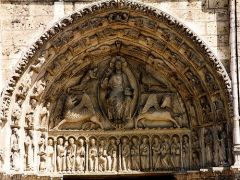
|
Royal Portals, Cathedral, Chartres, France, c. 1145-70 GOTHIC PERIOD
• Image of Biblical kings and queens • Figures are called “columnar figures because they are tall and thin like columns • All look straight out—no interaction between figures • Heads are small compared to length of the body • When there is a tall, skinny space, they will fill it with tall, skinny figures, like the Romanesque artists • Four figures next to each other—second from the left indicates that one leg is bent and the other is straight—an attempt to contraposto |
|
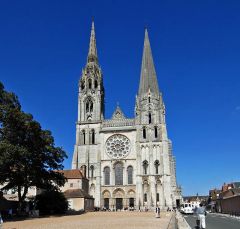
|
Cathedral, Chartres, rebuilt after 1194 GOTHIC PERIOD
• Built with thick walls to help support the towers • Exterior buttresses support all of the weight inside so there can be thinner piers o Inefficient fliers upon the buttresses because they are built at such a low angle which requires more support on the bases of the fliers • Two towers were built at different times • Houses the tunic Mary is believed to have worn when Christ was born • High Gothic Style—3 part elevation • Ribbed vaulting on the ceiling--quadripartite • The stained glass o Had problems with the wind so the supports had to be replaced with iron o The details of the faces were painted on, light modeling |
|

|
Cathedral, Reims, 1211-1286 GOTHIC PERIOD
• Familiar façade • Wanted to increase the height of the window; increases the amount of light • Doorways become a place where windows are located instead of sculpture; rose window has a surrounding archway with additional windows added • INSIDE o More windows=more light o Unusual that it has sculpted figures on the inside of the doors in rows up the wall; collection of people of the time that represent Christians o Sculptures • Pair of angles represent the annunciation; conversing with Mary but they are both acknowledging each other because the heads are turned toward one another • Minimal folds • Elongated proportions • Second pair of statues represent the visitation of Mary • Acknowledgment of each other • Artist obviously influenced by ancient art; much more natural because they are not quite as stretched out; in contraposto, and more intense drapery |
|

|
Abraham and the Three Angels, from the Psalter of St. Louis, 1253-1270 GOTHIC PERIOD
• Manuscript from King Louis X • Where 3 angles come to visit Abraham and his wife; possibly represent the trinity • Tree acts as a divider to distinguish the two parts of the story • Acts as a narrative instead of heavy symbolism • Second panel depicts the story of the promise of Sarah bearing children • The upper zone o Treated as if there was a gothic cathedral apart o the scene; suggests that these scenes were probably originated from a stain glass window—colors are those similar to those found in stained glass windows o Proportions • Tall and stretched out—just like stained glass • Abraham’s hat was similar to those worn by Jews of the time period |
|
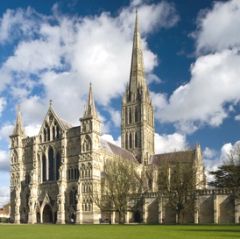
|
Cathedral, Salisbury, begun, c. 1220 GOTHIC PERIOD
• Constructed on the edge of a city and on a large open space so that the structure could be connected to a monastery • The cross in the center is where the tower is located above; located about half way down the nave • There are 2 transepts • Nave isn’t rounded but has 2 additional bays on the east end • Two turrets instead of two large towers as seen in French styles • Lancet windows instead of rose windows that provide the same amount of lights • Unusual for an English church because it has flying buttresses; unusual because these are not as tall as French • INSIDE o Two different colored stones used from the column to the arches |
|
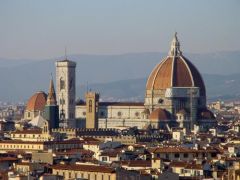
|
Cathedral, Florence, 1294-1366 GOTHIC PERIOD
• Freestanding tower that is separate from the main part of the building • Famous for its dome which was apart of the Renaissance • The end acts like an east end transept • 3 Clear story windows • No flying buttresses • Gothic elements on the inside o Ribbed vaulting o Small piers o No gallery on the 2nd floor |
|
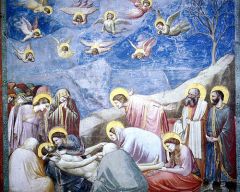
|
Lamentation, Arena Chapel, Padova, 1305-06 Artist: Giotto 14TH CENTURY ART IN EUROPE
• West wall is just an image of the last Judgment • Scene of Christ’s body is removed from the cross • Angels and the women are weeping at the death of Christ; hand to cheek signifies morning • John’s arm and head suggest he is crying out against anger • The rock wall is, compositionally, leading you to the scene of Christ’s body surrounded by people • Drapery, figures seem to have substance under their clothing |
|
|
|
Lamentation, Arena Chapel, Padova, 1305-06 Artist: Giotto 14TH CENTURY ART IN EUROPE
• West wall is just an image of the last Judgment • Scene of Christ’s body is removed from the cross • Angels and the women are weeping at the death of Christ; hand to cheek signifies morning • John’s arm and head suggest he is crying out against anger • The rock wall is, compositionally, leading you to the scene of Christ’s body surrounded by people • Drapery, figures seem to have substance under their clothing |
|
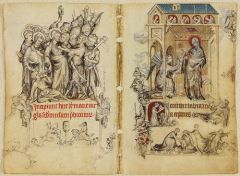
|
Book of Hours of Jeanne d’Evreaux, 1325-28, Artist: Jean Pucelle 14TH CENTURY ART OF EUROPE
• Pen and ink with some colors added throughout the scenes; reminiscent of stained glass windows • Gothic attitude while also using new style of trying to show interior architectural space • All figures are dressed in contemporary styles • Modeling used to create a nice illustration of the three dimensions • First scene is of the conviction of Christ • Second scene is of the Ennunciation o Mary and Gabriel—prior to this Mary was shown in front of a building—symbolic architecture you were supposed to know that it was occurring inside |
|
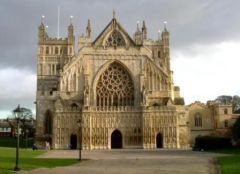
|

Cathedral, Exeter, England, 14th century GOTHIC PERIOD/ 14TH CENTURY ART OF EUROPE
• More complicated than earlier styles of Gothic; remember that English Gothic period buildings are not as tall as those in France • Lancet window out front instead of a rose window • Half columns on the front with surface decoration; sculpture quality kind of surface • INSIDE o With the nave elevation (3 part elevation) and as we saw at Salisbury, the columns isn’t the same decoration as that column that continues to the ceiling o The vaulting is quadripartite but the ribs are multiplied (doesn’t make the ceiling more structurally sound) |
|
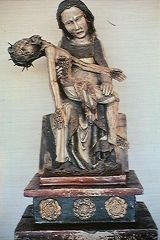
|
Vesperbild (Röttgen Pietà), c. 1300-1325 – Andächtsbilder 14TH CENTURY ART OF EUROPE
• Image that is meant to be thought-provoking; created for a particular purpose • Product of the artist’s desire rather than something that looks real • Carved out of wood that is painted • Expressive, unnatural, an appears to be gruesome • Mary’s hair is let down which is a sign of grief o Her expression is in utter shock • Body of Christ has streams of blood that look like flowers, very emaciated • Meant to be apart of prayers and to evoke an emotional reaction to make you feel how horrible it was to see Christ dead |
|
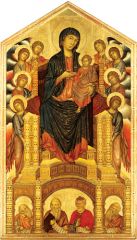
|
Virgin and Child Enthroned, c. 1280 Artist: Cimabue 14TH CENTURY ART OF EUROPE
• About 10 feet high • Mary is holding the Christ child • Below are figures of saints • Looks a lot like Byzantine Art; modeling is soft with faint shadows, the throne creates a sense of three dimensional space • Different than Byzantine art by the need to fill space completely with figures (angels) etc. |

